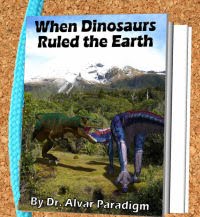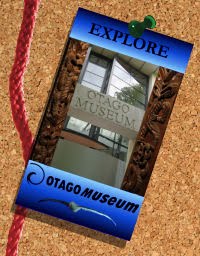so
i'd hit a bunch of dead ends (
here AND
here...) in trying to
find some information on
the pack of the primordial feather. this meant that
mike, the librarian, wasn't going to be able to help me track the primordials down here in town, that alone their mysterious
crate.
i was feeling kind of hopeless as i made my way out of the university of
calgary. how on earth was i going to find a handful of dinosaurs in a giant city like
calgary?
especially when they were trying to hide!
pulling me momentarily out of my depression, was a man that walked by me in the science building's lobby. it took my tiny brain a minute to click into who he was, but i thought he looked familiar...
then it hit me, and i sprinted after him...
 "doctor hildebrand?" i called, and fortunately for me i remembered right!
"doctor hildebrand?" i called, and fortunately for me i remembered right!
dr. alan hildebrand turned around and was slightly puzzled to see me (i assume more because he is not used to dinosaurs calling him down, rather then hearing his name) "yes," he said to confirm it was him. "how can i help you?"
i'd never met dr. hilderbrand before, but knew him by reputation and from his many appearances on science documentaries.
i quickly introduced myself, and he was kind enough to put up with my fanboy yammering for a couple of minutes.
why was i so in awe of meeting dr. hilderbrand you might ask?
well i shall answer that question... even if you didn't ask it!
in short he is one of "the dudes" when it comes to asteroid research...
 why his meteorite work is of interest to me in particular (not that asteroids aren't cool in their own right!) is that his most famous discovery related to space rocks was the one that (may) have wiped out the dinosaurs!
why his meteorite work is of interest to me in particular (not that asteroids aren't cool in their own right!) is that his most famous discovery related to space rocks was the one that (may) have wiped out the dinosaurs!
 you have probably heard this idea...
you have probably heard this idea...
a really big asteroid hit the earth 65 million years ago at the end of the cretaceous period (this impact in fact "caused" the end of the cretaceous as the extinction is what geologists used to define the periods end), and the damage its crashing into our planet was so powerful it devastated every known ecosystem of the time!

the asteroid gets lots of the blame, but in some ways it was the earth's "fault" things got so bad after the interstellar accident. the meteorite was going so fast and had so much energy that it exploded and vaporized when it hit the planet.
well this kicked a lot of things up into the air (and possibly higher then that!) ranging from dust to outright molten rock! that's right this was so big an impact that sky filled up with something very much like lava, which then rained down just like evaporated water normally does when it gets to heavy to stay in the air.
if the earth had been made of different stuff, this wouldn't have happened. so this is why i say the bad things that followed are as much due to do with the earth as the asteroid.

there was only one thing worse then raining lava (which no doubt did untold damage... which we find evidence of all over the world in rocks of this era), and was the smaller lighter dust and dirt that continued to float. after the heavier fiery stuff fell out of the sky (causing forest fires ALL over the world at the same time!!!), the cloud of dust lingered in the sky and blocked out all the light.
meaning there was no sun for plants to use in making food. if you get rid of plants the whole animal food chain falls apart!
this caused the final extinction of the dinosaurs (i say final, as the vast majority of dinosaurs species had gone extinct well before this event during our 160 million year existence, only the last few families still alive at this point were alive to be killed... which sounds weird i know, but is true!), and numerous other creatures of the time.
this whole sequence of events has pretty much been accepted by science. even people who don't know a lot about dinosaurs or palaeontology can tell you the rough story. however this wasn't always the case...
when this theory was first proposed by geologist walter alvarez and his father, super famous nobel prize winning physicist, luis alvarez it was hotly contested. one of the key problems they had in proving their theory, was where did the asteroid hit?

this is the part of the story where dr. hildebrand played a key role... though not at first.
a few years before the alvarez's proposed an asteroid impact 65 million years ago, in 1978 the crater site was indirectly discovered by geologist glen penfield. he recognized a number of anomalies in the local geography of the yucatán peninsula of southern mexico (i used to call yucatán the little alligator mouth at the bottom of north america...).
however due to an inability to get access to sites and better samples he was unable to work out what exactly he had stumbled across. penfield wrote up a paper about what he could only see as a cataclysmic event in the cretaceous, but suspected the final answer would be extraordinary...
many years later enter, then a grad student, alan hildebrand. he grew very interested in the theory of an asteroid impact and began trying to find the prehistoric crater as his grad project. unaware of glen penfield's work in mexico, hildebrand slowly began to close in on equatorial america as the most likely site. recognizing clues in haiti, hildebrand might have closed in on mexico by himself, but he then learned of glen penfield's findings.

hildebrand approached penfield, and the two resumed penfield's abandoned search from over a decade previous. it was a historic team up, and with hildebrand in america he could get access to the one thing penfield couldn't in mexico. old drill samples stored state side. analyzing these samples the two published on how they believed yucatán was the site of the meteorite's landing.
they would be proven correct. a later satellite survey from outer space would detect a still visible (underground buried mind you, but it was undistorted millions of years later and thus visible when you look through the rock with sensors) a nearly perfect circular crater.
so like many of the biggest discoveries, it took a lot of people to get to the truth. one of whom i was shaking the hand of here today!
 it was really cool to get to meet dr. hildebrand. sadly he didn't have time for a chat. i only really got to introduce myself.
it was really cool to get to meet dr. hildebrand. sadly he didn't have time for a chat. i only really got to introduce myself.
"well it was nice to meet you," dr. hildebrand said in conclusion. i thanked him for his time, and expected to be on my own way... then he caught me totally by surprise with another sentence. "hopefully i'll bump into you down in collections soon."
"what?" i asked in total confusion. then i thought i understood "oh no i don't work here at the university. they don't have an theropod 'lab rats'."
this seemed to make sense to dr. hildebrand. "that explains why i hadn't seen any of you guys down there before."
"guys?" i asked not following.
"your friends," dr. hildebrand offered, hoping i'd know what he was talking about. obviously my lack of following him came across. "all you theropods down in the geology collections."
did he just say what i think he did!?!
i begged dr. hildebrand to explain... i couldn't believe it, not only was he an asteroid guru, he may have just lead me right to the crate i so desperately was trying to find!
while going into the deep bowels of the uni's geology department's collections dr. hildebrand said he'd encountered a group of theropod dinosaurs in one of the more remote corridors of the basement. he figured they were just part of the palaeo departments dinosaur lab rat collection.
"were they coelurosaurs?" i asked.
"well i'm no expert," dr. hildebrand warned as he thought about it a second. "now that you mention it, if i had to go off my momentary observations, yes i would say they all were."
"thank you so much!!!" i said completely sincere to dr. hildebrand. "you have been a HUGE help! i have to go though."
before he could ask any questions, i sprinted away from
dr.
hildebrand. i needed to find a phone. i might have just found the elusive clue we needed to track down the pack! would it allow mike to pinpoint the primordials? i needed to find out right away, and so off i went...
thinking about now, i guess it was a little rude of my to run off on
dr.
hildebrand. it was for a good reason... hopefully
i'll get to meet him again and explain my reasons...
however now i had a pack hunt on my claws...
to be continued... with a lead?
































 "doctor
"doctor  why his
why his  you have probably heard this idea...
you have probably heard this idea...




 this used to be the power point introduction for an educational program where kids at camp would help sort micro fossils for actual scientific research by
this used to be the power point introduction for an educational program where kids at camp would help sort micro fossils for actual scientific research by 

 here is a bunch i found just today wandering a medium size coulee. this was the best clutch
here is a bunch i found just today wandering a medium size coulee. this was the best clutch  this is exactly the sort of fossil batch
this is exactly the sort of fossil batch 
 just as
just as 



 there are a few differences between these and the bone in my first journal entry.
there are a few differences between these and the bone in my first journal entry. which is what
which is what 
 hoisting myself up to the bone i looked in to examine it.
hoisting myself up to the bone i looked in to examine it. it may not have been an articulated skeleton
it may not have been an articulated skeleton  now as i found this
now as i found this  sadly there weren't any duplicate bones present on the surface. what means i couldn't find 2 of any one type of bone, such as two left femurs or two right wrist bones etc. if i could have, than i could confirm this was a
sadly there weren't any duplicate bones present on the surface. what means i couldn't find 2 of any one type of bone, such as two left femurs or two right wrist bones etc. if i could have, than i could confirm this was a 


























































